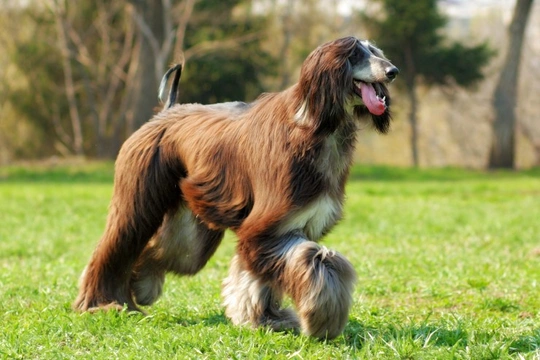
Learning more about Afghan hound myelopathy
The Afghan hound is a tall, lean and leggy dog breed from the Kennel Club’s hound grouping, and is a type of sighthound that is perhaps most notable for the long, flowing coat displayed by dogs of the breed.
Afghan hounds are very beautiful to look at as well as being refined, noble and affectionate, but those luxurious Afghan hound coats also require a lot of care and attention to keep them looking good and to avoid knots and tangles. They also tend to shed heavily, which can make maintaining their coats and keeping shed hair from making a mess something of a challenge.
If you have a particular soft spot for sighthounds and have your heart set on owning one of the more unusual and certainly most distinctive looking dogs of this type, the Afghan hound is certainly worth considering. Whilst they do of course have a very fast running speed, dogs of the breed tend to be fairly sedentary as a whole, and enjoy chilling out on the sofa in between walks, and so don’t have hugely onerous exercise requirements.
However, as is the case for virtually all pedigree dog breeds, the Afghan hound is at risk of inheriting a number of different hereditary health problems that can be passed on from parent dogs to their litter. One such condition is called Afghan hound myelopathy, and this is a degenerative condition of the spinal cord that is thought to exclusively affect dogs of the Afghan hound breed.
The condition cannot be cured or reversed, and will ultimately lead to paralysis in affected dogs – which means that all Afghan hound owners and prospective owners should learn the basics of the condition and how it presents, in order to make an informed assessment of the risk factors for any given dog.
In this article, we will look at Afghan hound myelopathy in more detail. Read on to learn more.
What is Afghan hound myelopathy?
Afghan hound myelopathy is a progressive, degenerative disorder that develops gradually over time and that ultimately leads to hind limb paralysis.
Whilst the condition itself is not usually painful, it has a significant impact on the health and quality of life of affected dogs, and generally results in a decision to put affected dogs to sleep at the point that it progresses to having a significant impact on the dog’s normal lifestyle and happiness.
Afghan hound myelopathy usually begins with a gradual loss of normal coordination in the back legs, which causes an unusual walking gait, instability, and potentially, dragging the paws of the hind legs. Over time as the condition becomes more acute, the dog’s legs will weaken further, to the point that they are no longer able to support their weight, and have difficulty simply standing up.
Generally, Afghan hound myelopathy takes around six months to a year from the onset of symptoms to reach the acute stage, although in some cases, it may take longer.
What sort of dogs can develop Afghan hound myelopathy?
Afghan hound myelopathy is thought to be a condition that exclusively affects dogs of the Afghan hound breed, hence the name. The condition affects both males and females equally, and may develop in juvenile and young adult dogs or in some cases, not until the dog in question is older.
As a breed-specific health condition, Afghan hound myelopathy is considered to be hereditary in nature, but at present there is no health testing protocol in place to identify the early makers of the condition within dogs. However, an Afghan hound who had a parent or other close relative with Afghan hound myelopathy is exponentially more likely to develop the condition themselves.
What are the symptoms of afghan hound myelopathy?
Afghan hound myelopathy develops in stages over a period of time, which can make identifying Afghan hound myelopathy symptoms challenging. It is a progressive condition that worsens as it develops, and that is very obvious when acute.
Some of the symptoms of Afghan hound myelopathy you might notice at home include:
• An anomalous gait or strange movement pattern that begins in the hind legs.
• Tremors or weakness in the hind legs.
• Dragging the paws of the back legs when walking.
• Problems rising or standing.
• Instability and a tendency to fall over when walking.
• Once acute, the dog is likely to be unable to stand at all.
• Faecal and urinary incontinence may follow.
Can Afghan hound myelopathy be cured?
Unfortunately, there is no way to prevent a dog from developing Afghan hound myelopathy, and the condition cannot be treated and cured once it has developed.
Care for a dog with Afghan hound myelopathy is concerned with supporting the dog and making their lives easier whilst suffering from the condition, which involved making allowances for their problems with moving around normally and keeping them safe and happy.
Once Afghan hound myelopathy reaches the acute stage and the dog’s quality of life is no longer acceptable, a decision is usually made to euthanise the dog to prevent further suffering.
Afghan hounds with Afghan hound myelopathy can pass the condition on to their own offspring, and so should not be used for breeding.



